-
Posts
6258 -
Joined
-
Last visited
-
Days Won
2
Content Type
Profiles
Forums
Events
Posts posted by michel123456
-
-
10 hours ago, Inkaddict said:
Hello,
With the cooler temperatures I noticed an interesting thing happening with my ceiling fan when I lowered the speed to the lowest setting while still pushing the air downward. During the summer this fan ran continuously on the highest setting with a little bit of wobble in it. With the the fan at the lower setting the wobble has increased so much that the pull chain now swings back and forth with enough momentum to connect with hanging lights. I suspect the cause of the wobble is due to one of the arms that attach the blades to the motor is slight bent, maybe causing a different pitch to one of the fan blades or there is a weight imbalance between the blades themselves. My question is what would cause the wobble to be more pronounced at the lower speed than at the higher speed scientifically that is. I'm sure that there are centrifugal forces in play here but could the directional forces created by the fan blades circulating the air be a stabilizing factor?
My guess is that the wobble appears the same way it appears when a spinning top slows down. https://en.wikipedia.org/wiki/Top#Physics
0 -
-
7 hours ago, Occcams5 said:
I did the math and came to 700 BC
4399 years/2 = 2199.5 before 1400
1400 minus 2199.5 gives -799.5 minus year zero thus 800.5 BC
Or 3000 minus 2199.5 = 800.5 BC
And FYI (from http://railsback.org/FQS/FQS.html )
 0
0 -
24 minutes ago, joigus said:
You missed the diacritics and the fact that these forums are in English. The capital in 'One' clearly suggests the partition 'Curios'+'One'.
But you're right. Only they know.
Ha. My name is in French, and clearly the special code at the end (123456, my invention & copyrighted) is in French!
i was the only one to know that, now you know.
0 -
10 hours ago, joigus said:
You declare yourself "curious one," but you sound pretty incurious:
Lack of rigor: his name is Curiosone. This is an international Forum.
Maybe he is Italian or Swiss (like Toblerone).
Or maybe from Curio https://darkestdungeon.gamepedia.com/Curio
He (she) only knows.
10 hours ago, joigus said:Hormones play a role in all this. I must deal with youngsters every day, and I know only too well. Some very promising students behave like idiots just because of their hormones. You must know this if you're a teacher, or else you can and will do real damage to very valuable brains.
That is why I dislike the minus rep points.
0 -
Certainly this Forum is not adequate for young people. If it is @CuriosOne's case, I understand his reaction.
1 -
On 10/26/2020 at 1:18 PM, Eise said:
you should see that your diagrams with all these connection lines have next to nothing to do with the real situation.
About the "connection lines":
Here below an ANALOGY
You remember this picture showing foreshortening.
Below my own hand from one side % the reverse:

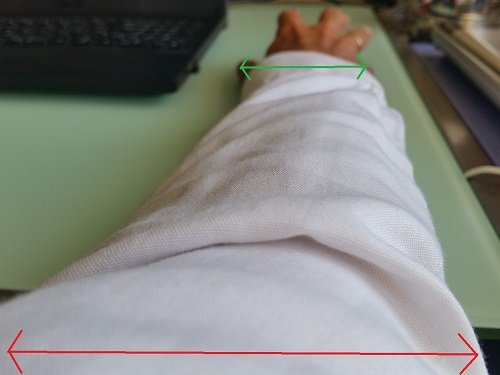
Very roughly, let's assume that, as a real measurement, the red distance is the same lenght as the the green one.
Because of the effect of perspective, they look different depending on the position of the camera; the "apparent length" is observer dependent.
Apparently, length 1 (red) and length 2 (green) are linked by "connection lines" in white color.
The situation is perfectly symmetric. The length of line 1 (red) in the first picture corresponds to line 2 (green) in the second, and the length of line 2 (green) in the first corresponds to line 1 (red)in the second.
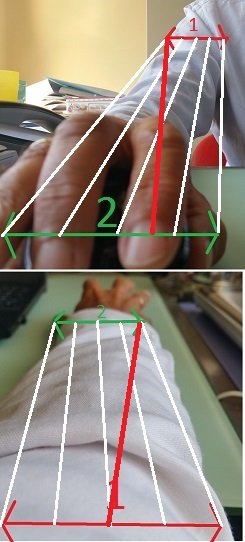
If someone links lines 1 & 2 with a bold red line that "jumps" somehow vertically between lines 1 & 2, it is possible to calculate some result of the operation but the result will correspond to exactly nothing.
If you want to "jump" from line 1 to line 2, you must follow the white lines. Otherwise the result is wrong.
0 -
Some time ago, I learned about the "screaming skeletons", or why archaeologists uncover ancient skeletons & mummies that look like screaming in horrid agony.
Your jaw bone ascends toward the back (almost at a right angle to the horizontal line of the teeth), ending in a rounded protuberance (the condyloid process), which fits into a shallow groove in your temporal bone on the lower part of your skull. (For more, see Gray's Anatomy of the Human Body, especially the sections "Articulation of the Mandible" and "The Mandible (Lower Jaw)".
(...) The nature of this joint is a key to understanding why mummies scream. Physician Trisha Macnair explains in "Human decomposition after death" on the BBC Health website.
"This temporo-mandibular joint is fairly loose.... Unlike the tight ball-and-socket linking the leg and the hip, the jaw and cranium are held together only by ligaments and muscles. If unimpeded--by the position of the body, wrappings, or very fast desiccation--the jaw will drop down as the muscles relax and decompose after rigor mortis."
See full article "the screaming mummies"
https://archive.archaeology.org/online/features/screaming_mummy/
1 -
On 10/23/2020 at 11:12 PM, Janus said:
Your error is that you again are not taking relativity of simultaneity into account. To illustrate, we can put clocks at the end of rod attached to B and at the point's along the rods.
Thus from The E-X rest frame you get this:
The green boxes indicate two clocks passing each other and their respective readings as they do.
In the rest frame of B, you get this:
Comparing the the times shown in the green boxes as clocks pass each other agree with those in the first image.
In each image, there is a an instance when two pairs of clocks pass at the same time, but they are different pairs of clocks in each image. This just illustrates that, with the Relativity of simultaneity, events that are simultaneous for one frame of reference are often not simultaneous for another.
I am very attentive to your analysis. You have time on the vertical axis, distance on the horizontal, and...time again on the horizontal? Ticking at a different rate for the moving FOR? And not ticking for the FOR at rest?
13 hours ago, Eise said:Yep. If I see it correctly, this is Janus 4th diagram in the series 'In the rest frame of B, you get this:'.
I also had the idea that you would run into troubles because of the relativity of simultaneity. Janus worked it out into the last detail. It might look complicated, but you did it to yourself, by introducing rods that add nothing to the original situation. Really, Markus already said it clearly: it is not possible to derive some inconsistency in the framework of relativity. You behave like somebody who still thinks he can trisect an angle.
Here below the diagram, that as you said is the same with one of Janus (it cannot be totally wrong):
The problem with it is that I believe there is a small mistake in it: the vertical line above X.
Explanation: the length contraction factor makes a direct link between the 1LH in the FOR at rest and the 1LH in the moving FOR.
It remains 1LH length but measured differently. The link is diagonal, like this below:
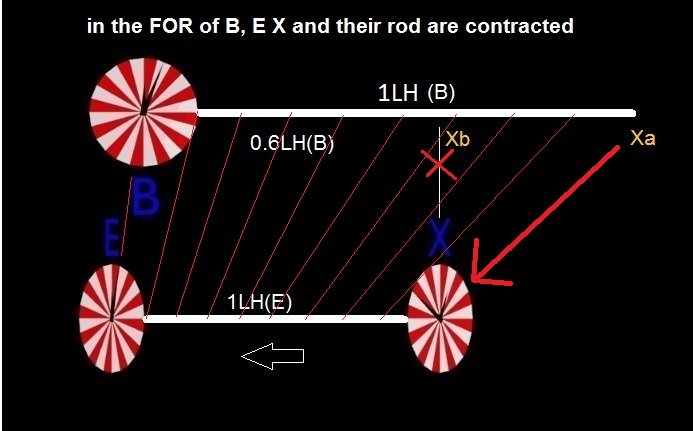
The contraction link goes from Xa to X. It goes from 0,6 LH above to 0,6 LH below. It goes along the thin red lines.
There is no vertical link.
And there is a way to corroborate, as a posted previously.
Take attention at point Xb. This point lies at 0,6 LH as measured by B (at rest). It correspons to the 45min calculated by @Eise, when it is supposed that B reaches X (or X reaches B) as measured by B.
See here below:
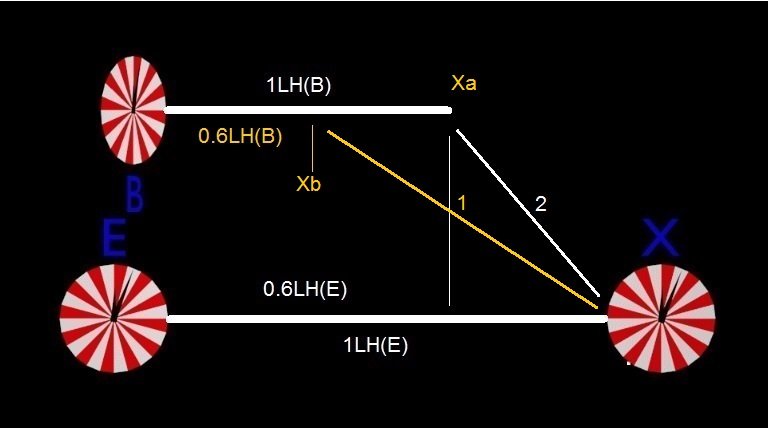
Do you spot point Xb on the diagram? Do you really believe that B will reach X at point Xb?
Where is the correct length contraction? Is it between Xb & X (Line 1) or between Xa & B (Line 2)?
Don't you see that point Xb is the result of a (erroneous) double contraction (0.6 of a contracted line)?
I let you ponder carefully.
0 -
6 hours ago, Eise said:
The distance B must travel is given by E-X. This distance is 1Lh in the FOR of E-X, but 0.6Lh in the FOR of B.
Are you saying this?
diag5.
0 -
On 9/23/2020 at 5:39 PM, swansont said:
Is the “length” moving? No. So it’s not contracted.
Is that your objection? (still searching the quote)
26 minutes ago, Eise said:Uh?
'The distance'? Here you go again. Not mentioning which distance from which frame
In E-X's FOR, the distance between E and X is 1Lh.
So for B, moving with 0.8c, he sees the distance he must travel as 0.6Lh.
There are no other relevant distances for this situation. Lengths of poles connected to B just play no role. Why, B could be a rocket of 1 Lh long. The only thing that interests us is the passing of the observer in B with his clock, passing E and X.
No, I think that you are wrong there.
The distance 0.6 LH is the one from the FOR of E-X. As in diag2.
From the FOR of X-E, what B seem to experience is a change of scale. The units are changing. The meters are smaller & the seconds are smaller too (so that velocity remains the same)
In its own frame, B does not travel 0.6 LH, it still travels 1LH.
diag2
In the FOR of B, in 45 min B will travel & reach point Xb on the following:
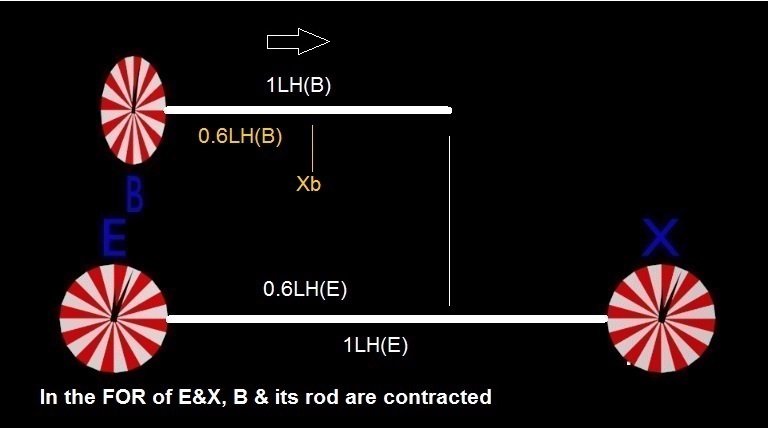 On 9/23/2020 at 7:10 PM, md65536 said:On 9/23/2020 at 5:39 PM, swansont said:
On 9/23/2020 at 7:10 PM, md65536 said:On 9/23/2020 at 5:39 PM, swansont said:Is the “length” moving? No. So it’s not contracted.
Do you mean the lengths between the dice? Those lengths are contracted, see (b).
Here's a thought experiment to show that the spaces between objects are contracted the same as objects themselves: Consider the dice in their rest frame. Put an enclosure around each die, and connect them with sticks. In the moving frame, everything contracts, and the dice never leave the enclosures. The distance between the dice must contract the same as an object of the same length.
0 -
11 hours ago, swansont said:
Provide a quote where anyone said that,
Ouaouch the syndrome hit again.
0 -
1 hour ago, Eise said:
Wrong. Which distance? See above: we started from the fact that in the FOR of E-X, the distance between E and X is 1 Lh. So X must travel this distance to get to the place where E was, and B still is. And in X's FOR, this is still 1Lh.
This is exactly the point where the situation is not symmetrical, as I said in my first point above (made a few typos, I correct them here):
Applying MD's rule:
From the FOR of X, Is B moving?
If B is moving then the distance is contracted. Which, I agree with you, was not the opening statement. Thus we have an inconsistency.
-----------------------------------------
Look, I know the distance is 1LH, I am trying to show you that the situation as you are presenting it is not symmetric. That is why @Bufofrog is insisting so much on acceleration. But IMHO it is wrong. There is no account for acceleration in any of the maths formulas that have been used so far. The setting can be imagined with bypassing clocks, not even jumping from one FOR to another, but simply reading instantly the clock in the other FOR. The change of FOR by acceleration is an excuse to avoid the inconsistency.
But I believe there is another way to explain what is happening.
Look at my diag1 and diag2 again.
If you spot an error there please tell me.
0 -
X is traveling toward B.
Exactly as B is traveling toward X
The setting is one, these are not two different situations. Simply the observer changes, once in the FOR of B, once in the FOR of X.
In the FOR of B the distance to travel is contracted (following your arguments). So in the FOR of X the distance to B should be contracted too, because B is moving.
So, being symmetrical, B's time to travel is 45min (following your arguments) and X's time to travel should also be 45 min.
Which does not give the expected result.
0 -
According to your scenario one could argue that X is traveling and measures 45 min of travel.
0 -
10 hours ago, Bufofrog said:
Δt′=Δt1−v2c2√
Where Δt is the clock rate of the observer (stationary frame).
But both are in a stationary frame.
It has been stated here that for the observer "at rest" the time to reach planet X is 1h:15min
For the "moving" observer it has been stated that it is 45min.
Now, if you keep in mind that the situation must be so that you cannot know who is the "moving" and who is the "at rest", you get the confusion I struggle with.
0 -
1 hour ago, Bufofrog said:
(...)
If the ship and the planet's weren't ever in the same reference frame and just flew by each other, then both would see the other time dilated.
Show me.
0 -
17 minutes ago, Eise said:
In the 'B-close-passing-E-and-X' example, yes. (...)
In this case, why is it that the situation is not mirrored?
I mean,
_from the FOR of E, you said that B's clock ticks 45 min while reaching the goal (at X)
and
_from the FOR of B, you said that X's clock will show 1h:15 while ticking only 23 min.
Why such a difference?
If all are inertials, the situation should be exactly reversible, isn't it?
0 -
37 minutes ago, Eise said:
OK, it was you who started to talk about the twin paradox again.
In the 'one-way, B passing by E and X' there is not even a 'seeming paradox'. Given that E and X's clocks are synchronised in their FOR, and B passes very close by E and X, all observers agree that B's clock showed 0:00 when it passed E, and B's clock shows 0:45 when passing X. Also, all observers agree that E's clock stands at 0:00 when B passes close by, and that X's clock stands at 01:15 when B passes by.
E-X and B only disagree about how much B traveled through time and how much through space. But they fully agree on the spacetime-distance of the events.
- Distances in space do not change if you turn your coordinate system in space.
- Distances in spacetime do not change if you turn your coordinate system in spacetime.
Lorentz transformations are rotations in spacetime.
But do you agree that they are all inertials?
0 -
6 minutes ago, swansont said:
How does the traveling twin return without accelerating (which changes their frame)?
You could imagine a 3rd "twin", bypassing X in the opposite direction.
But that is not necessary, you can consider the outbound trip only, it is sufficient. If there is a temporal difference between the traveling clock & the synchronized clock on planet X, then the paradox will arise.
In previous examples on this thread, the concept of "bypassing" instead of "starting" is clearly used to avoid the effects of acceleration.
In such a way that all the components, Earth, planet X and traveling clock B are inertial.
0 -
3 hours ago, Eise said:3 hours ago, michel123456 said:
Now, some may argue that there is no paradox, because “we know who is moving and who is at rest”.
Nobody said something like that here. It makes no sense to ask who is moving and who isn't. But it does make sense to ask who changes its inertial frame, and who doesn't.
3 hours ago, Ghideon said:My version:
Now, those with knowledge about relativity will argue that there is no paradox, because we know who was accelerating and who was not.I disagree. You can set up the "paradox" without acceleration & without any change in inertial frame. IIRC it has been stated in this same thread previously.
0 -
This is the world upside down.
A paradox is usually an argument that is very (very) bad for a Theory. If a new pet theory was presented here that drives into a paradox, the pet theory would be rejected immediately.
In this case, the twin paradox has become a feature of Relativity.
As if the paradox helped the Theory, instead of hurting it.
Now, some may argue that there is no paradox, because “we know who is moving and who is at rest”.
Is that correct? If B moves relative to E, or if E moves relative to B, does it matter for the equations of physics who is “really” moving? I don’t think so.
0 -
1
-
On 10/15/2020 at 2:08 AM, Charles 3781 said:
Which accounted for why burned ashes weighed more than the original wood.
Where did you get that idea?
0



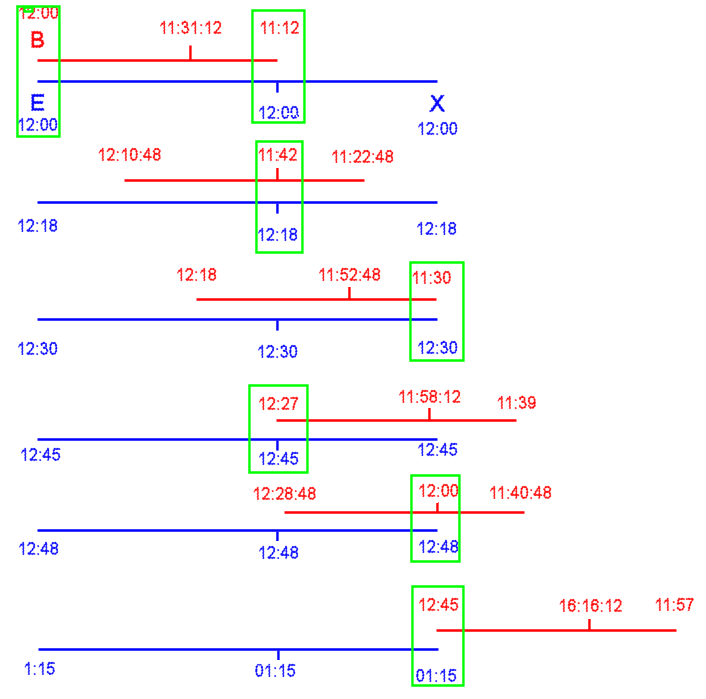
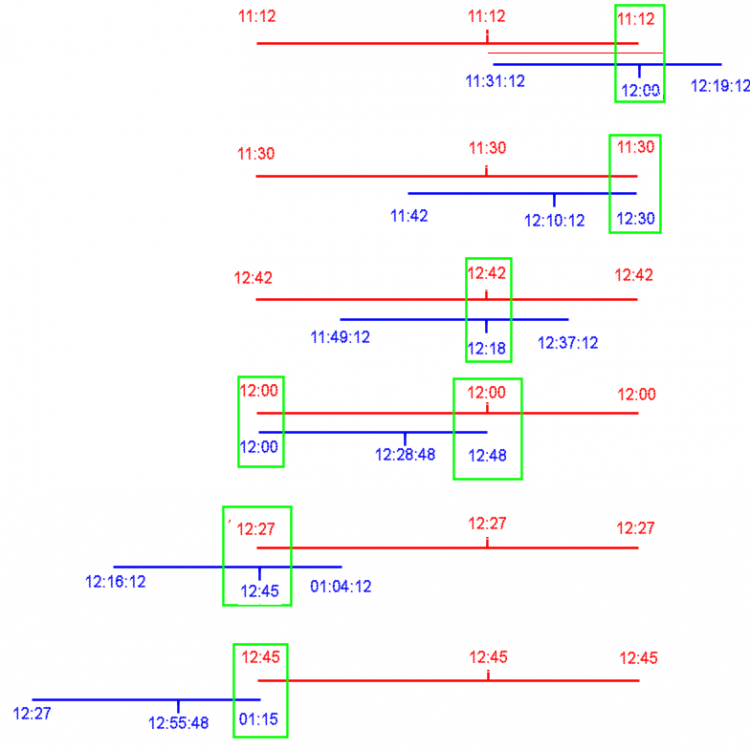
The Official JOKES SECTION :)
in The Lounge
Posted
Translated by me from https://www.socomic.gr/en/2018/01/kourafelkithra-socrates/